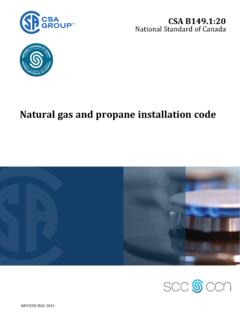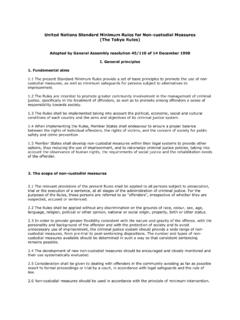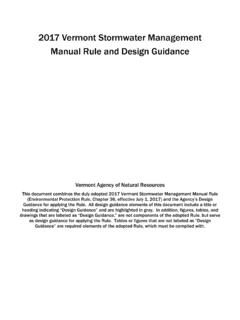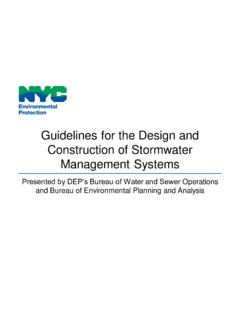Transcription of Shipping KPI Standard
1 The Shipping KPI Standard Released 1st January 2018. The Shipping KPI Standard Page 1 of 146. Shipping KPI Standard 1 Table of Contents 2 Concepts .. 6. Hierarchy of indicators .. 6. Shipping Performance Indicators (SPI).. 7. Key Performance Indicators (KPI) .. 8. Performance Indicators (PI) .. 9. KPI 10. 3 Shipping Performance Indexes .. 11. Environmental Performance .. 11. Health and Safety Performance .. 12. HR Management Performance .. 13. Navigational Safety 14. Operational 15. Security Performance .. 16. Technical Performance .. 17. Port State Control 18. 4 Key Performance Indicators .. 19. Ballast water management violations .. 19. Budget performance .. 21. Cadets per ship .. 22. Cargo related incidents .. 23. CO2 efficiency .. 25. Condition of class .. 27. Contained spills .. 29. Crew disciplinary frequency .. 31. Crew planning .. 33. Drydocking planning performance .. 35. Environmental deficiencies .. 37. Failure of critical equipment and systems .. 39.
2 Fire and Explosions .. 41. Port State Control performance .. 43. The Shipping KPI Standard Page 2 of 146. Health and Safety deficiencies .. 45. HR 47. Lost Time Injury Frequency .. 49. Lost Time Sickness Frequency .. 51. Navigational deficiencies .. 53. Navigational incidents .. 55. NOx efficiency .. 57. Officer retention rate .. 59. Officers experience rate .. 61. Operational deficiencies .. 62. Passenger injury ratio .. 64. Port state control deficiency ratio .. 66. Port state control detention .. 68. Releases of substances .. 70. Security deficiencies .. 72. SOx efficiency .. 74. Training days per officer .. 76. Ship availability .. 78. Vetting deficiencies .. 79. 5 Performance Indicators .. 81. Actual Drydocking costs .. 81. Actual drydocking duration .. 82. Actual unavailability .. 83. Agreed drydocking budget .. 84. Agreed drydocking 85. Number of officers employed .. 86. Emitted mass of CO2 .. 86. Emitted mass of NOx .. 89. Emitted mass of SOx .. 90. Last year's AAE (Additional Authorized Expenses).
3 92. Last year's actual running costs and accruals .. 93. Last year's running cost budget .. 94. Number of absconded crew .. 95. Number of allisions .. 96. The Shipping KPI Standard Page 3 of 146. Number of ballast water management violations .. 97. Number of beneficial officer terminations .. 98. Number of cadets under training with the DOC 99. Number of cargo related 100. Number of cases where a crew member is sick for more than 24 hours .. 101. Number of cases where drugs or alcohol is abused .. 102. Number of charges of criminal offences .. 103. Number of collisions .. 104. Number of conditions of class .. 105. Number of contained spills of liquid .. 106. Number of seafarers not relieved on time .. 107. Number of dismissals .. 108. Number of environmental related deficiencies .. 109. Number of explosion incidents .. 110. Number of failures of critical equipment and systems .. 111. Number of fatalities due to work injuries .. 112. Number of fatalities due to sickness.
4 113. Number of fire incidents .. 114. Number of groundings .. 115. Number of health and safety related deficiencies .. 116. Number of HR related deficiencies .. 117. Number of logged warnings .. 118. Number of lost workday 119. Number of navigational related deficiencies .. 120. Number of officer days onboard all ships with the DOC holder .. 121. Number of officer experience points .. 122. Number of officer terminations from whatever cause .. 123. Number of officer trainee man days .. 124. Number of officers onboard .. 125. Number of operational related deficiencies .. 126. Number of passengers injured .. 127. Number of permanent partial disabilities .. 128. Number of permanent total disabilities (PTD) .. 129. Number of PSC 130. The Shipping KPI Standard Page 4 of 146. Number of PSC inspections .. 131. Number of PSC detentions .. 132. Number of PSC inspections resulting in zero deficiencies .. 133. Number of recorded external inspections .. 134. Number of releases of substances to the environment.
5 135. Number of security related deficiencies .. 136. Number of oil spills .. 137. Number of unavoidable officer 138. Number of ships operated under the DOC holder .. 139. Number of observations during commercial inspections .. 140. Number of commercial inspections .. 141. Number of violations of rest hours .. 142. Passenger exposure hours .. 143. Planned unavailability .. 144. Total exposure hours .. 145. Transport work .. 146. The Shipping KPI Standard Page 5 of 146. 2 Concepts Hierarchy of indicators The Shipping KPI Standard is built up hierarchical with 8 Shipping Performance Indexes (SPIs), 33 Key Performance Indicators and 64 Performance Indicators (PIs). There is a mathematical relation between SPIs (high level indexes) which are calculated from Key Performance Indicators, and KPIs which are calculated from Performance Indicators (lowest level). On the lowest level you find the PIs, which are based on data capture (measurements or counters) directly from a ship or from the Shipping management.
6 Data is collected once and re-used within the Shipping KPI. Standard in order to reduce the amount of data. On KPI level a form of normalisation take place. The KPI are scaled into a range from 0-100, where zero indicates unacceptable and 100 is outstanding performance. This makes it possible to compare ships with different characteristics or amount of data captured. Finally, on the highest level the KPIs are combining into Shipping Performance Indexes in order to express performance within specific main areas. The Shipping KPI Standard Page 6 of 146. Shipping Performance Indicators (SPI). The Shipping Performance Indexes (SPIs) are aggregated expressions of performance within a particular area. The SPIs are expressed as a weighted average of relevant KPI Ratings on a scale between 0 and 100. Some Key Performance Indicators (KPI) can be included in several SPIs. An example is the KPI Crew planning which is used in calculation of all SPI Ratings. The objective of the SPIs is to give external stakeholders information about the overall performance of a ship in one of the following areas: Environmental Performance Health and Safety Performance HR Management Performance Navigational Safety Performance Operational Performance Security Performance Technical Performance Port State Control Performance The Shipping KPI Standard Page 7 of 146.
7 Key Performance Indicators (KPI). The Key Performance Indicators (KPIs) are expressions of performance within a specific area. The KPIs ratings will form basis for the Shipping Performance Index (SPI) score. The KPIs can be expressed in two ways; a KPI Value which is a mathematical combination of relevant Performance Indicators Values and a KPI Rating which is an expression of the KPI Value on scale between 0 and 100 where a high rating (100) is a result of high/excellent performance. Some PI Values can be included in the calculation of more than one KPI Value. Examples of KPIs are: Budget performance, Drydocking planning performance and Ship availability. A KPI is: a numerical, objective measure of performance key to the strategic business objective actionable and influenced by the relevant stakeholder/manager accountable to stakeholder/manager output oriented, not focused on input or activity possible to calculate with limited efforts and within limited time The objectives of KPIs are to: measure for continuous improvement measure for internal and external benchmarking measure to set incentives The Shipping KPI Standard Page 8 of 146.
8 Performance Indicators (PI). The Performance Indicators (PIs) are the building blocks giving the basis for KPI Value calculations. PIs are directly observable parameters (measurements) for each ship under management, Number of dismissals, Number of collisions and Number of fire incidents. The Performance Indicators are the only elements that must be reported manually or by means of implemented ICT solutions. Focus has been to provide the hierarchy with unambiguous definitions of measurable low level parameters based on existing measurements in the industry. Each PI may be used in the calculation of several Key Performance Indicators (KPIs). An example is the PI Number of recorded external inspections which is used as a denominator in the calculation of several KPI Values. The Shipping KPI Standard Page 9 of 146. KPI Depository The depository contains detailed information about the Shipping KPI Performance Hierarchy through: 1. Description of all Performance Indicators including: 1.
9 Specification of data capture (PI Values). 2. Their context in light of how the PI Values are used in the hierarchy 3. Any intermediate calculation formulas that must be applied to be able to obtain the PI. Values 2. Description of all Key Performance Indicators including: 1. The KPI's objective (what to measure). 2. The KPI Value calculation formula 3. The KPI Rating calculation formula. 3. Description of all Shipping Performance Indexes including: 1. The SPI's objective (what to express). 2. The SPI Rating calculation formula. The clarification of roles and responsibilities related to the management of the Shipping KPI Depository is under the responsibility of the Project Steering committee until the end of the project, after that InterManager has agreed to take over the maintenance of the Standard . However, the actual work may be contracted to a different organization, and the Shipping KPI Depository may be hosted by a 3rd party provider. The maintenance will at a minimum consist of: Updates and enhancements of the web service Revision of the SPI/KPI/PI descriptions QA support service Management of the ICT platform The Shipping KPI Standard Page 10 of 146.
10 3 Shipping Performance Indexes Environmental Performance Description Environmental Performance is an expression of the organisation's ability to avoid spills and reduce emissions that impact the environment, caused by the ship operations. Recorded for each single ship. SPI001 is measured in '%'. Formula to calculate value Dependencies KPI028 Releases of substances KPI001 Ballast water management violations KPI007 Contained spills KPI011 Environmental deficiencies KPI005 CO2 efficiency KPI021 NOx efficiency KPI030 SOx efficiency The Shipping KPI Standard Page 11 of 146. Health and Safety Performance Description Health and Safety Management Performance is an expression of the organisation's ability to effectively manage the health and safety of the personnel onboard. SPI002 is measured in '%'. Formula to calculate value Dependencies KPI017 Lost Time Injury Frequency KPI015 Health and Safety deficiencies KPI018 Lost Time Sickness Frequency KPI025 Passenger injury ratio KPI013 Fire and Explosions The Shipping KPI Standard Page 12 of 146.







